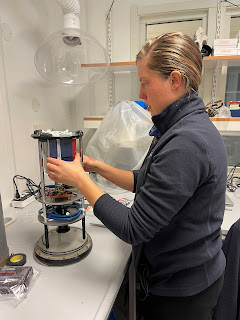 |
Checking all the parts of CATAIN in the lab.
Photo by Alexa Elliott, Changing Seas/South
Florida PBS. |
Imagine that you are a camera system. You were invented in Woods Hole, Massachusetts by a group of scientists and engineers with a mission to study the ocean. You were designed to
photograph settlers, they told you, so they named you CATAIN. They deployed you
beneath the pier in Woods Hole for tests, then to
collect data over the course of a year. You were submerged
in winter,
in summer, and alongside
other panels for comparison. You dreamed of the day that you would fulfill your true purpose - not recording photos of settlers in Woods Hole where the scientists could check on you, but truly going where no settlement study has gone before. You yearned to see the remote environments you were designed for. You strove to earn the trust of your inventors so they would someday send you off on a solo mission. Where would you imagine going? Somewhere offshore, a polar environment, the deep sea? Which location would help you fulfill your calling, you autonomous camera system? Where would you want to be deployed?
Ladies and gentlemen, CATAIN has embarked on its first solo mission in a remote environment: Kongsfjorden, Svalbard, Arctic. Yesterday at 1300 hours, the world's first autonomous settlement camera was deployed on the seafloor at 15 meters depth at 79 degrees north. There it will remain, anchored in place for about a year. While CATAIN operates solo, it is certainly not alone in its liquid location. Just a few meters away is Ny-Ålesund's old pier, and a similar distance in another direction is an underwater observatory run by the Alfred Wegener Institute.
 |
Kharis and I with our creation. Photo by Alexa Elliott,
Changing Seas/South Florida PBS.
|
Anytime you put equipment in the ocean, there are million things that can go wrong. I'm actually kind of shocked that we got to this point, because CATAIN had sat in the warehouse at the research station for about a year. When we arrived, I wasn't even sure if it would work anymore - but it did. The batteries charged; the computer woke up; the camera worked; and the housing even sealed properly.
For the deployment, Kharis and I built a box for CATAIN to sit on. We braided ropes together to make a bridle. We filled the box with anything heavy we could find - there were some concrete blocks in storage at the marine lab, and we also grabbed rocks from the beach. We secured the whole thing with rope, ratchet straps, bolts, and nuts. When the crane of our research vessel, Teisten, heaved CATAIN up off the deck, the box creaked but didn't break. Our homemade deployment system actually seemed to work.
 |
Deploying CATAIN in Kongsfjorden. Photo by
Alexa Elliott, Changing Seas/South Florida PBS. |
We chose 15 m as our target depth for a few reasons. That's the depth CATAIN was deployed at in Woods Hole, so the data should be at least partially comparable. It's deep enough that the camera is not likely to get completely covered in kelp, which would obscure our view of the animals, and it's also not super likely to get destroyed by an iceberg (although there's still a non-zero possibility that something could happen). We marked the camera with an underwater buoy, took a GPS point, and triangulated the location with reference to nearby structures. Unless there's a catastrophe, we should be able to find it again.
If we succeed, CATAIN will provide us with the first-ever data on settlement and post-settlement mortality patterns in Arctic benthic invertebrates. We will test the hypothesis first proposed in 2013 that for some species, settling during the polar night could actually be advantageous, because they can grow large enough to withstand competition from other species during the spring bloom. We will answer scientific questions that were never before possible to answer in remote environments, and I will be extremely proud. If we succeed.
So far, so good. Long live CATAIN.



Comments
Post a Comment